The TRS-80 Model I
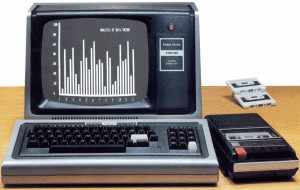
A Model I with monitor and cassette recorder from a Radio Shack catalog
The TRS-80 (which became known as the Model I after the Model II was introduced in 1979) was created by Don French and Steve Leininger. It ran a Zilog Z80 at 1.77 MHz and came with 4K of RAM, and a 4K ROM of what was called Level I BASIC. Only uppercase characters could be displayed, and the only means of storage was a cassette recorder. Despite these limitations, the TRS-80 was enormously successful. The initial production run sold out in less than a month, and it took almost a year for Radio Shack to catch up with the demand. Radio Shack sold 100,000 TRS‑80 computers in 1978, over four times its nearest competitor.
Here is the original press release announcing the TRS-80:
The latest development in electronics for the home, according to Radio Shack, is a complete, low-cost microcomputer system.
Just introduced by the nationwide electronics store chain is the new Radio Shack TRS-80 Microcomputer System. Not a kit, the TRS-80 comes completely wired and tested, ready to plug in and use.
Uses for the microcomputer around the home could include personal finance management and evaluation of investment portfolios. In the kitchen the TRS-80 may be used for storing recipes, keeping a running inventory of groceries, menu planning and converting recipes for larger or smaller servings than usual.
For the student in the home, the TRS-80 can be used as an aid to learning mathematics, music theory and virtually any subject through programmed teaching methods. And, just for fun, a variety of game programs will be available, including blackjack and backgammon.
The original Model I system was composed of three pieces:
- the computer with power supply and built-in keyboard (catalog number 26-1001) costing $399.95
- a 12-inch display (catalog number 26-1201) costing $199.95
- a Realistic CTR-41 cassette recorder (catalog number 14-841) costing $49.95
When those components were bought together (as almost everyone did), a complete system (catalog number 26-1051) cost $599.95. Both the keyboard and monitor were colored battleship grey (also known as Mercedes Silver). Unlike many microcomputers at the time, the Model I was U.L. listed.
The Model I also included User’s Manual for Level I (catalog number 26-2101) written by Dr. David A. Lien. This manual was an excellent introduction to Level I BASIC and computers in general.
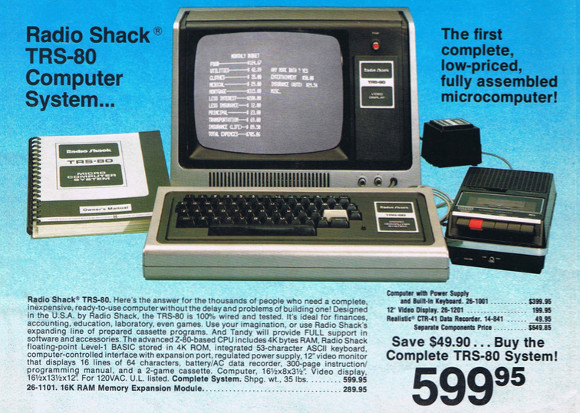
The Model I introduced in a Tandy Computers catalog
Specifications
The TRS-80 Model I had very impressive specifications for a $399.95 computer in 1977:
- a Zilog Z80 processor running at 1.77 MHz
- a monochrome, uppercase-only text display, with either 64 columns by 16 rows or 32 columns by 16 rows
- 128 by 48 low-resolution graphics
- cassette storage capable of either 250-baud (in Level I) and 500-baud (in Level II)
- 53-key professional keyboard
- 4K of memory, expandable to 16K
Expanding the Model I further required a device called an Expansion Interface. This provided:
- 32K of memory, for a total of 48K
- a single-density floppy disk controller
- a parallel printer port
- an RS-232 port
In addition to the Radio Shack version, there were many third-party Expansion Interface alternatives, such as Holmes Expansion Mainframe, the Exatron MM+, the Microtek MT-32, the Lobo LX-80, the Micromint Disk-80, or the LNW System Expansion.
Configurations
There were four versions of the Model I:
- Level I 4K (catalog number 26-1051) for $599.95 (later $499.00)
- Level I 16K (catalog number 26-1053) for $889.00 (later $729.00)
- Level II 4K (catalog number 26-1054) for $698.00 (later $619.00)
- Level II 16K (catalog number 26-1056) for $988.00 (later $849.00)
Radio Shack also sold various Model I configurations bundled with hardware and software. These included the “Educator” for $1198.00, “Engineer” for $1456.95, “Professional” for $2384.00, and “Business” for $3874.00.
Existing Level I systems could be upgraded to the more powerful Level II BASIC by purchasing the Level II BASIC (ROM) Kit (catalog number 26-1120) for $120.00.
Software
When the Model I was introduced in 1977, Radio Shack offered only five programs, all for Level I and all on cassette:
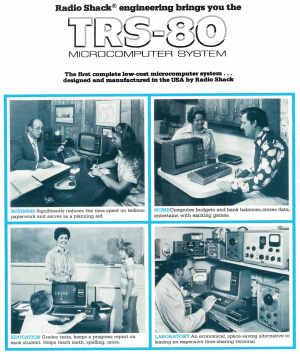
One of the many pictures of a Model I in a kitchen from a Radio Shack catalog
- Game Package (catalog number 26-1801) cost $4.95, but was included with the Model I.
- Payroll Program – 12 Employees (catalog number 26-1501) cost $19.95.
- Education – Math 1 (catalog number 26-1701) cost $19.95.
- Kitchen1 (catalog number 26-1601) cost $4.95.
- Personal Finance (catalog number 26-1602) cost $14.95.
This soon changed as Radio Shack rapidly expanded their software library. A third-party TRS-80 software industry sprang up. Radio Shack periodically published TRS-80 Applications Software Sourcebook, a (incomplete) listing of third-party software for the TRS-80 with thousands of entries. By 1979, the TRS-80 was widely regarded as having the largest software library of any computer2. As Stephen Gray wrote in the December 1980 issue of Creative Computing:
Yes, the other popular personal computers have a lot of programs, but nowhere near the variety and number written for the Level II TRS-80.
As late as 1982, a Radio Shack advertisement stated “there’s more software for the TRS-80 than any other microcomputer.” By 1985, Radio Shack software sales alone totaled $100 million dollars, making them one of the largest sellers of software in the world.
Hardware
There were an incredible number of hardware add-ons available for the Model I, both from Radio Shack and many third-party companies.
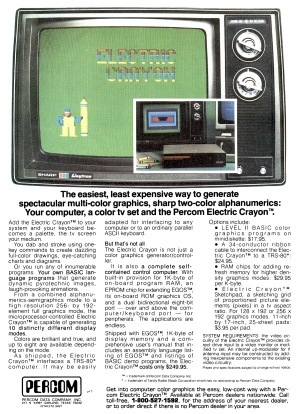
Advertisement for the Electric Crayon
A few of the options for storage included the Exatron Stringy Floppy, Meca BETA-80, or the JPC Products TC-8.
There were CP/M add-ons, such as the Omikron Mapper, the Freedom Option, the Shuffleboard, the Holmes VID-80, and the BIGMEM. For those who wanted to run MS-DOS software, there was even the MicroMerlin. These examples only scratch the surface of what was available.
The range of hardware add-ons meant that it was common for Model I owners to heavily expand their computers. Sometimes this meant that their computers became more powerful than competing machines from years later.
Operating systems
The original Model I disk operating system was TRSDOS, written by Randy Cook. Like the unmodified Model I, it worked only in single density. The original versions of TRSDOS had speed and reliability problems, which were addressed with subsequent updates. The final updated version was TRSDOS 2.3.
Many people developed their own patches to TRSDOS to fix bugs and add new features. This process of patching spawned a thriving third-party market of new but TRSDOS compatible operating systems for the TRS-80. Among the most popular were DOSPLUS, LDOS, NEWDOS, and MULTIDOS. All of these were later modified for double-density support and were rewritten to run on the Model III.
Radio Shack released one other Model I operating system much later. This was TRSDOS 2.7, a double-density operating system designed for the Radio Shack doubler. This version of TRSDOS was not compatible with the other versions, and never achieved much popularity.
The Model III
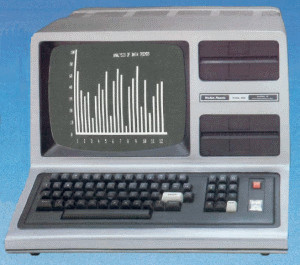
The Model III from a Radio Shack catalog
In 1980, Radio Shack introduced the TRS-80 Model III. The Model III was almost completely compatible with Model I software. It corrected some of the deficiencies of the Model I, including lowercase characters, internal memory expansion, and a printer port. It also added some nice features such as double-density disk support and 1500-baud cassette transfers.
Although the Model III wasn’t originally intended to replace the Model I, it worked out that way. Problems with making the Model I meet new stringent FCC guidelines led to Radio Shack discontinuing the Model I in the United States in November or December 1980. All the remaining Model I computers sold out in January 1981, although Radio Shack continued to sell the Model I outside the United States for several years3. As late as 1984, 80 Micro estimated that 250,000 were still in use.
In 1983, the Model III was replaced with the Model 4. In 2005, Radio Shack finally reused the Model I’s 26-1001 catalog number.
-
Kitchen was later renamed Home Recipe. Early promotional photographs for the Model I often showed it set up on a kitchen table, although it’s hard to imagine anyone ever used it that way. The 26-1601 catalog number was reused for the word processor Scripsit Pro in 1986. ↩︎
-
The Apple II software library probably overtook the TRS-80 Model I/III in 1980 or 1981. This corresponded to the rapid increase in sales of the Apple II, but also to Radio Shack introducing new computers that split TRS-80 programmers among the Model II, Color Computer, and Model III. ↩︎
-
Although it was never officially acknowledged, these final Model I’s (sold outside the United States) included a slightly redesigned video circuit (to replace an obsolete RAM chip) that had built-in lowercase. According to some people, at least some of the final Model I’s sold in the United States also had undocumented lowercase. ↩︎
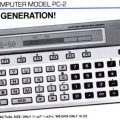
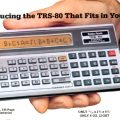
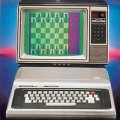
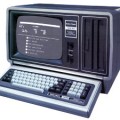










Ben Govett says:
There were 2 model I’s released, a level I and a later level II. Level I had no numeric keypad, the Level I basic ROM, and 4KB of RAM. The Level II was later released including a numeric keypad, level II basic ROM and 16KB of RAM.
I owned both, and still have a working level II.
Jeremy Hall says:
Brilliant website – my first desktop computer was the TRS80 Model 1 but I started using computers personally since 1967 and I am currently creating a website exploring the last 50 years – your information about TRS80 provides valuable reminders (with links back to your site). Thanks.